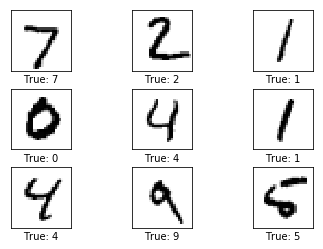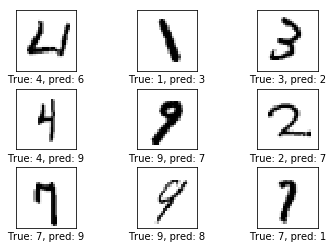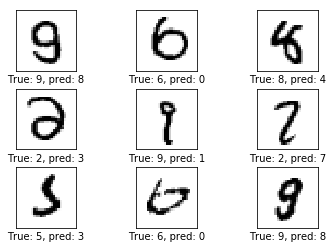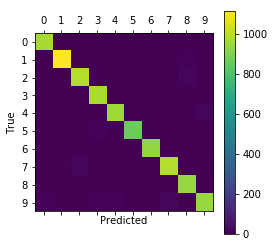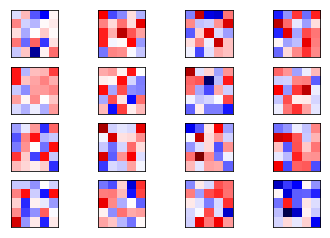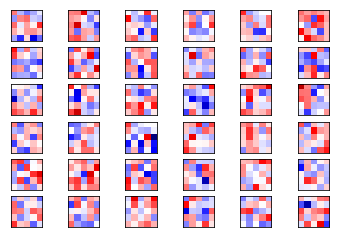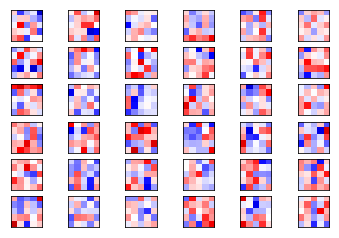PrettyTensor 之前的轮子用prettytensor再造一遍
前戏 引入各种包和MNIST 1 2 3 4 5 6 7 8 9 %matplotlib inline import matplotlib.pyplot as pltimport tensorflow as tfimport numpy as npfrom sklearn.metrics import confusion_matriximport timefrom datetime import timedeltaimport mathimport prettytensor as pt
1 2 3 from tensorflow.examples.tutorials.mnist import input_datadata = input_data.read_data_sets('data/MNIST/' , one_hot=True ) data.test.cls = np.argmax(data.test.labels, axis=1 )
定义图片相关大小 1 2 3 4 5 img_size = 28 img_size_flat = img_size * img_size img_shape = (img_size, img_size) num_channels = 1 num_classes = 10
1 2 3 4 5 6 7 8 9 10 11 12 13 14 def plot_images (images, cls_true, cls_pred=None ): assert len (images) == len (cls_true) == 9 fig, axes = plt.subplots(3 , 3 ) fig.subplots_adjust(hspace=0.3 , wspace=0.3 ) for i, ax in enumerate (axes.flat): ax.imshow(images[i].reshape(img_shape), cmap='binary' ) if cls_pred is None : xlabel = "True: {0}" .format (cls_true[i]) else : xlabel = "True: {0}, pred: {1}" .format (cls_true[i], cls_pred[i]) ax.set_xlabel(xlabel) ax.set_xticks([]) ax.set_yticks([]) plt.show()
1 2 3 images = data.test.images[0 :9 ] cls_true = data.test.cls[0 :9 ] plot_images(images=images, cls_true=cls_true)
PrettyTensor 运算 定义变量 placeholder是原始数据,训练的时候不变。
Variable 是训练的时候的哪些变量。
1 2 3 4 x = tf.placeholder(tf.float32, shape=[None , img_size_flat], name='x' ) x_image = tf.reshape(x, [-1 , img_size, img_size, num_channels]) y_true = tf.placeholder(tf.float32, shape=[None , num_classes], name='y_true' ) y_true_cls = tf.argmax(y_true, axis=1 )
开始骚操作 pt.defaults_scope(activation_fn=tf.nn.relu) 的意思:activation_fn=tf.nn.relu 是 with这个block里每一层的参数。
1 2 3 4 5 6 7 8 9 10 x_pretty = pt.wrap(x_image) with pt.defaults_scope(activation_fn=tf.nn.relu): y_pred, loss = x_pretty.\ conv2d(kernel=5 , depth=16 , name='layer_conv1' ).\ max_pool(kernel=2 , stride=2 ).\ conv2d(kernel=5 , depth=36 , name='layer_conv2' ).\ max_pool(kernel=2 , stride=2 ).\ flatten().\ fully_connected(size=128 , name='layer_fc1' ).\ softmax_classifier(num_classes=num_classes, labels=y_true)
1 2 3 4 def get_weights_variable (layer_name ): with tf.variable_scope(layer_name, reuse=True ): variable = tf.get_variable('weights' ) return variable
1 2 3 4 weights_conv1 = get_weights_variable(layer_name='layer_conv1' ) weights_conv2 = get_weights_variable(layer_name='layer_conv2' ) print (weights_conv1)print (weights_conv2)
<tf.Variable 'layer_conv1/weights:0' shape=(5, 5, 1, 16) dtype=float32_ref>
<tf.Variable 'layer_conv2/weights:0' shape=(5, 5, 16, 36) dtype=float32_ref>
1 2 3 4 optimizer = tf.train.AdamOptimizer(learning_rate=1e-5 ).minimize(loss) y_pred_cls = tf.argmax(y_pred, axis=1 ) correct_prediction = tf.equal(y_pred_cls, y_true_cls) accuracy = tf.reduce_mean(tf.cast(correct_prediction, tf.float32))
跑两步 1 2 3 4 5 6 7 8 9 10 11 12 13 14 15 16 17 18 19 20 21 session = tf.Session() session.run(tf.global_variables_initializer()) train_batch_size = 64 total_iterations = 0 def optimize (num_iterations ): global total_iterations start_time = time.time() for i in range (total_iterations, total_iterations + num_iterations): x_batch, y_true_batch = data.train.next_batch(train_batch_size) feed_dict_train = {x: x_batch, y_true: y_true_batch} session.run(optimizer, feed_dict=feed_dict_train) if i % 100 == 0 : acc = session.run(accuracy, feed_dict = feed_dict_train) msg = "Optimization Iteration: {0:>6},\ Training Accuracy: {1:>6.1%}" print (msg.format (i + 1 , acc)) total_iterations += num_iterations end_time = time.time() time_dif = end_time - start_time print ("Time usage: " + str (timedelta(seconds=int (round (time_dif)))))
1 2 3 4 5 6 7 8 def plot_example_errors (cls_pred, correct ): incorrect = (correct == False ) images = data.test.images[incorrect] cls_pred = cls_pred[incorrect] cls_true = data.test.cls[incorrect] plot_images(images=images[0 :9 ], cls_true=cls_true[0 :9 ], cls_pred=cls_pred[0 :9 ])
1 2 3 4 5 6 7 8 9 10 11 12 13 def plot_confusion_matrix (cls_pred ): cls_true = data.test.cls cm = confusion_matrix(y_true=cls_true, y_pred=cls_pred) print (cm) plt.matshow(cm) plt.colorbar() tick_marks = np.arange(num_classes) plt.xticks(tick_marks, range (num_classes)) plt.yticks(tick_marks, range (num_classes)) plt.xlabel('Predicted' ) plt.ylabel('True' ) plt.show()
1 2 3 4 5 6 7 8 9 10 11 12 13 14 15 16 17 18 19 20 21 22 23 24 25 26 27 28 test_batch_size = 256 def print_test_accuracy (show_example_errors=False , show_confusion_matrix=False ): num_test = len (data.test.images) cls_pred = np.zeros(shape=num_test, dtype=np.int ) i = 0 while i < num_test: j = min (i + test_batch_size, num_test) images = data.test.images[i:j, :] labels = data.test.labels[i:j, :] feed_dict = {x: images, y_true: labels} cls_pred[i:j] = session.run(y_pred_cls, feed_dict=feed_dict) i = j cls_true = data.test.cls correct = (cls_true == cls_pred) correct_sum = correct.sum () acc = float (correct_sum) / num_test msg = "Accuracy on Test-Set: {0:.1%} ({1} / {2})" print (msg.format (acc, correct_sum, num_test)) if show_example_errors: print ("Example errors:" ) plot_example_errors(cls_pred=cls_pred, correct=correct) if show_confusion_matrix: print ("Confusion Matrix:" ) plot_confusion_matrix(cls_pred=cls_pred) print_test_accuracy()
Accuracy on Test-Set: 15.1% (1511 / 10000)
1 2 optimize(num_iterations=1 ) print_test_accuracy()
Optimization Iteration: 1, Training Accuracy: 28.1%
Time usage: 0:00:00
Accuracy on Test-Set: 15.5% (1549 / 10000)
1 2 optimize(num_iterations=99 ) print_test_accuracy()
Time usage: 0:00:05
Accuracy on Test-Set: 47.6% (4756 / 10000)
1 2 optimize(num_iterations=900 ) print_test_accuracy(show_example_errors=True )
Optimization Iteration: 101, Training Accuracy: 40.6%
Optimization Iteration: 201, Training Accuracy: 60.9%
Optimization Iteration: 301, Training Accuracy: 71.9%
Optimization Iteration: 401, Training Accuracy: 71.9%
Optimization Iteration: 501, Training Accuracy: 79.7%
Optimization Iteration: 601, Training Accuracy: 84.4%
Optimization Iteration: 701, Training Accuracy: 84.4%
Optimization Iteration: 801, Training Accuracy: 81.2%
Optimization Iteration: 901, Training Accuracy: 82.8%
Time usage: 0:00:37
Accuracy on Test-Set: 88.7% (8871 / 10000)
Example errors:
1 2 3 optimize(num_iterations=9000 ) print_test_accuracy(show_example_errors=True , show_confusion_matrix=True )
Optimization Iteration: 1001, Training Accuracy: 92.2%
Optimization Iteration: 6201, Training Accuracy: 100.0%
Optimization Iteration: 6301, Training Accuracy: 96.9%
Optimization Iteration: 6401, Training Accuracy: 96.9%
Optimization Iteration: 6501, Training Accuracy: 96.9%
Optimization Iteration: 9801, Training Accuracy: 100.0%
Optimization Iteration: 9901, Training Accuracy: 96.9%
Time usage: 0:06:18
Accuracy on Test-Set: 96.9% (9691 / 10000)
Example errors:
Confusion Matrix:
[[ 970 0 1 1 0 0 2 2 4 0]
[ 0 1117 2 1 1 0 3 0 11 0]
[ 5 2 993 6 2 0 2 7 15 0]
[ 2 1 5 977 0 8 0 8 8 1]
[ 1 1 3 0 957 0 3 1 2 14]
[ 3 1 0 11 0 866 4 2 4 1]
[ 7 3 3 1 5 5 931 0 3 0]
[ 0 7 17 3 1 1 0 992 2 5]
[ 5 0 2 8 5 1 3 4 943 3]
[ 9 8 1 10 11 3 0 14 8 945]]
卷积层分析 1 2 3 4 5 6 7 8 9 10 11 12 13 14 15 def plot_conv_weights (weights, input_channel=0 ): w = session.run(weights) w_min = np.min (w) w_max = np.max (w) num_filters = w.shape[3 ] num_grids = math.ceil(math.sqrt(num_filters)) fig, axes = plt.subplots(num_grids, num_grids) for i, ax in enumerate (axes.flat): if i<num_filters: img = w[:, :, input_channel, i] ax.imshow(img, vmin=w_min, vmax=w_max, interpolation='nearest' , cmap='seismic' ) ax.set_xticks([]) ax.set_yticks([]) plt.show()
1 plot_conv_weights(weights=weights_conv1)
1 plot_conv_weights(weights=weights_conv2, input_channel=0 )
1 plot_conv_weights(weights=weights_conv2, input_channel=1 )

